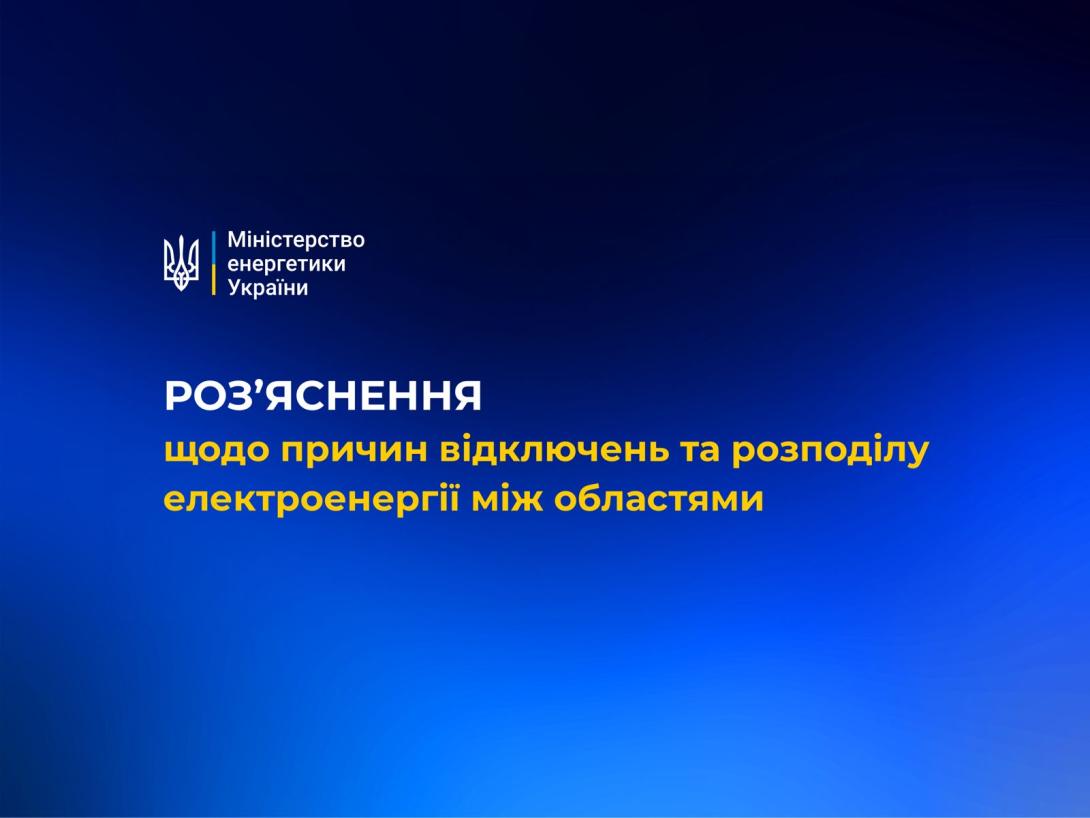Why are outages being applied?
The large-scale missile and drone attacks carried out by Russia against the Ukrainian power system in October–November resulted in significant losses of available capacity due to the destruction or damage of generation, transmission, and distribution facilities.
Because of ongoing Russian strikes, several regions in Ukraine are experiencing severe energy shortages. As Ukraine operates a unified power system, the issue of capacity deficit affects the entire grid, not just individual areas.
The inability to meet the demand of all consumers with the currently available capacity necessitates the introduction of forced restrictions — emergency outages (GAВ) or scheduled hourly outages (GPВ).
The key principle of system operation is that electricity production must equal consumption at every moment. Even a few percent of imbalance can lead to system emergencies.
Therefore, to balance the power system and ensure the equitable distribution of electricity, load-shedding schedules have been introduced for both households and businesses.
Why are some regions subject to consumption restrictions, while others are not?
Certain regions have been more severely affected by Russian attacks, while others have been less impacted. As Ukraine operates a synchronized national power system, the Russian-induced capacity deficit requires that consumption in the affected regions be partially covered by generation located in other oblasts.
Electricity from generating facilities is transmitted via high-voltage transmission lines and further distributed through distribution networks. Imported electricity enters the system through interconnectors.
However, the Ukrainian power system was never designed for wartime conditions and missile attacks. The technical capability to transmit electricity over hundreds of kilometers from power plants to end users is limited.
To partially unload the transmission network, it becomes necessary to impose restrictions in regions located along the transmission path from power plants and cross-border interconnectors (used for imports) to the distribution networks of energy-deficit areas.
At the same time, in regions through which such power transfer is not occurring, restrictions may not be required. These regions may even experience a local surplus of capacity that cannot be technically transmitted to areas where generation and transmission/distribution infrastructure have been damaged.
Who is responsible for preparing and overseeing adherence to the hourly outage schedules?
The following responsibilities are clearly defined for the Transmission System Operator (TSO), Distribution System Operators (DSOs), and the State Energy Supervision Inspectorate:
NPC “Ukrenergo” (TSO):
- Determines the required volume of restrictions (number of GPВ queues: half-queue, one queue, one and a half queues, two queues, etc.) for each region and each specific hour.
- Ukrenergo does not disconnect consumers and does not prepare consumer outage schedules; instead, it communicates to DSOs the required number of GPВ queues.
Distribution System Operators (DSOs):
- Prepare consumer outage schedules for each of the six queues (12 sub-queues).
- Coordinate the schedules with the respective Regional Military Administration (RMA).
- Ensure fair distribution of restrictions (total outage duration, rotation of day/night outages) within each region.
State Energy Supervision Inspectorate:
- Oversees compliance with fairness and adherence to the schedules.
Hourly outage schedules are prepared and published on the websites of the DSOs in each region. The schedules also indicate the time needed for switching between groups (queues) to perform required technical and safety operations.
What determines the volume of restrictions (number of GPВ queues)?
The volume of restrictions depends on the degree of imbalance between electricity generation and consumption. It is influenced by factors such as the number of power plant units in operation, the condition of the networks, and a range of additional technical parameters.
During the application of GPВ, critical infrastructure facilities (water utilities, heat supply facilities, hospitals, defense enterprises) are not disconnected.
The list of critical infrastructure facilities is approved by the respective Regional Military Administrations (RMAs).
Can electricity imports solve the capacity deficit and eliminate the need for outages?
Electricity imports are a very important tool for maintaining the balance between available system capacity and consumption levels. However, due to the geographic location of interconnectors, covering the deficit in regions that have lost their own generation is also limited by the capacity of transmission and distribution networks.
Given the risks — including Russian attacks on substations that ensure power transmission from Ukrainian nuclear power plants — Ukrenergo has already agreed on increasing the maximum import capacity to 2,300 MW in December.
GPВ are not applied to consumers who meet the requirements of the Regulation on the specifics of electricity imports under martial law, approved by Resolution No. 1127 of the Cabinet of Ministers of Ukraine dated 27 October 2023.
What causes changes to outage schedules during the day?
In the event of a sudden, unforeseen increase in network load, the dispatcher must immediately take action to reduce it. In such cases, emergency outage schedules (GAВ) may be applied, regardless of the previously prepared GPВ.
The duration of GPВ may change depending on the operational situation in the power system. If repairs increase the available system capacity, the duration of outages is correspondingly reduced.
Which documents regulate the application of power outages?
Order of the Ministry of Energy and Coal Industry of Ukraine No. 654 of 15.10.2015
“On approval of the Instruction on preparation and application of hourly outage schedules” (as amended).
Registered with the Ministry of Justice of Ukraine on 28 January 2016 under No. 153/28283.
https://zakon.rada.gov.ua/laws/show/z0153-16#Text
Order of the Ministry of Fuel and Energy of Ukraine No. 456 of 23.11.2006 (as amended)
Registered with the Ministry of Justice of Ukraine on 19 February 2007 under No. 151/13418.
“On approval of the Instruction on preparation and application of consumption restriction schedules, emergency outage schedules, and anti-emergency load-shedding systems.”









